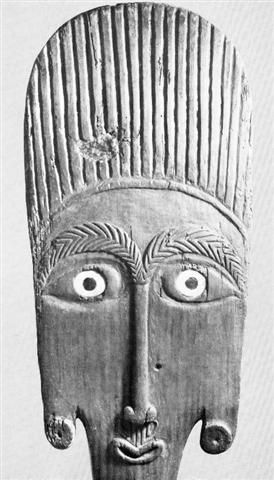4. That the main variant of vaha kai indeed can be read as a mouth becomes evident when we consider how the sign has been used in the face of this ao ('dance paddle'):
The for us peculiar form of the upper lip can been explained: "... what appears to be a full-frontal face in Maori art is actually a split representation composed of two profile forms, a feature of Maori tattoo and carving first described by LÚvi-Strauss (1963: 256-64) following Boas's analysis of the same phenomenon in North-west Coast American Indian art (Boas 1955: 223ff). Split representation allows all the essential features of a three-dimensional animal or human to be shown clearly without perspective distortion on a flat or relief surface or on a three-dimensional form different from the natural animal form. This obviously meets the need of a 'conceptual' art anxious to represent ancestors correctly with all necessary details present. Split representations explains the deep v-shape between the brows of Maori faces, the frequently doubled nose and the convergence of lips at the centre line of the face." (Starzecka) |
